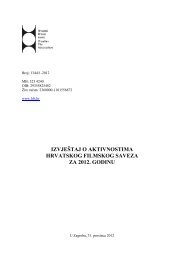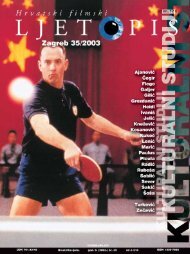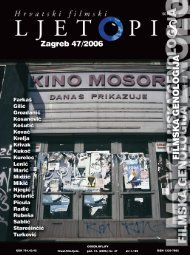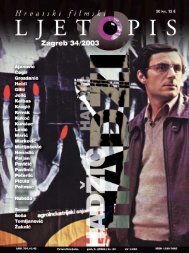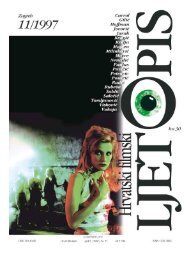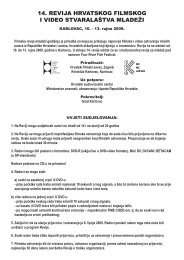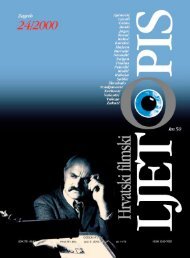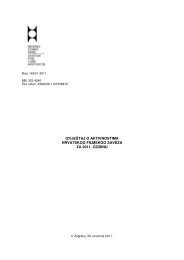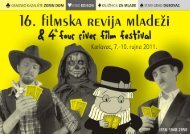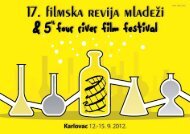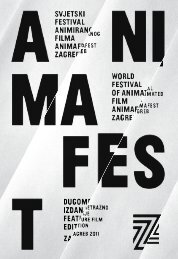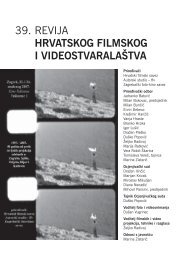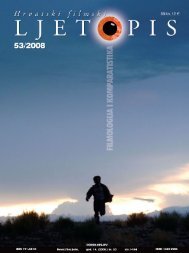Hrvatski filmski ljetopis, broj 26 (2001) - Hrvatski filmski savez
Hrvatski filmski ljetopis, broj 26 (2001) - Hrvatski filmski savez
Hrvatski filmski ljetopis, broj 26 (2001) - Hrvatski filmski savez
Create successful ePaper yourself
Turn your PDF publications into a flip-book with our unique Google optimized e-Paper software.
All this could also be said of Piotr Dumala’s films (1956)<br />
who is, along with Jerzy Kuciu, one of the leading contemporary<br />
Polish animators.<br />
Dumala is a graduate of the Academy of Fine Arts in<br />
Warsaw, his current living and working place. For a part of<br />
the year he lectures film animation in Sweden, in the Higher<br />
Artistic School in Eksjö. His films have won almost all the<br />
awards an animator could win. He won several prizes at the<br />
festivals of animation in Annecy, Ottawa, Hiroshima,<br />
Stuttgart and he won the Grand Prix in Zagreb in 1992.<br />
A combination of his various studies and interests created<br />
Dumala’s fascinating technique of animation. He places<br />
plasterboard painted in black under the camera. Each phase<br />
of movement is engraved with thin needles. He scratches the<br />
paint and thus obtains white lines and hatches on the dark<br />
background. Each drawing has a very high graphic value.<br />
However, after being recorded, every drawing is repainted<br />
with black paint so that they live shorter than a drawing<br />
made by a finger on a steamy window. His work has placed<br />
him among the greatest creators who have improved the<br />
technique of animation with original innovations.<br />
Almost all of his films are black and white, while he only<br />
occasionally and discretely uses some other colour. His films<br />
emit a strong sense of loneliness and loss, fear and anguish:<br />
man is shown as a live being buried in the dark world very<br />
much resembling a grave.<br />
Author of the text analyses Dumala’s films Lycantrophy<br />
(1981), Little Black Riding Hood (Czarny Kapturek, 1983),<br />
Flying Hair (Latajace Vlosy, 1984), Gentle (Lagodna, 1985),<br />
Jittery Life in Space (Nerwowe Zycie Kosmosu, 1986), Walls<br />
(Sciany, 1987), Freedom of the Leg (Wolno{} nogi, 1988),<br />
Franz Kafka (1991), Crime and punishment (Zbrodnja i<br />
Kara, 2000) and concludes that Dumala’s films are based on<br />
cartoon figuration, however, almost all of the above films<br />
include elements of non-figural, geometrical forms and pursue<br />
an imitation of motion picture ’realism’. His most significant<br />
heritage, however, is Polish satiric graphics. The<br />
foundations of Dumala’s aesthetic are Kafka’s work and philosophy,<br />
while Kafka’s influence and love of literature<br />
defined basic features of his art. Nevertheless, the ultimate<br />
value of Dumala’s films lies in the fact that under a thick<br />
layer of darkness, fear and anxiety hides a treasury of<br />
authentic humour presented in the form of bitter irony and<br />
sarcasm. ANALITICAL CONTENT: The Polish tradition of<br />
animation / Piotr Dumala / Dumala’s authentic style of animation<br />
/ Dumala’s films: beginnings / Dumala and Kafka /<br />
Piotr Dumala’s filmography.<br />
struggle for its independence. The social context of these<br />
periods can be very clearly, if indirectly, read in [orak’s<br />
work. [orak’s first long meter The Little Train Robbery<br />
(1984) refers to the period of deconstruction of the Austro-<br />
Hungarian monarchy and the creation of the first south-<br />
Slavenian state and comments on the inner disproportions<br />
of such society. Social context is even more evident in the<br />
film An Officer with a Rose (1987). Although the story takes<br />
place immediately after World War II, the film is not only an<br />
illustration of doubts and anxieties that were characteristic<br />
of the post-war years, it is also the illustration of the period<br />
it was filmed in. A deeper view into the social context of the<br />
film reveals three protagonists who are the personifications<br />
of three different social codes that formed after the war,<br />
which also manifested themselves in the second half of the<br />
eighties. The military, civic society and provincial people are<br />
distinctly separated with no possibility of ever really coming<br />
together. In the film Blood Drinkers (1989), evil is shown as<br />
a constant peril hanging over every society, which is, on the<br />
other hand, only partly aware of its presence. The film The<br />
Time of Warriors (1991), shot on the eve of the homeland<br />
war already anticipated the upcoming struggle, while Garcia<br />
(1999) dealt with the weaknesses of the society in which the<br />
film was made and with a past too troublesome to be completely<br />
revealed. Confrontation with the past represents a<br />
confrontation with the toilsome past of the newborn society<br />
still struggling and taking shape. [orak’s characters display<br />
little optimism. They stoically endure the situation they are<br />
in accepting it as a matter of fact they cannot change. They<br />
are aware that one cannot escape one’s destiny; their only<br />
goal is to complete their struggle.<br />
Dejan [orak is a traditional author who abhors any sort of<br />
extreme form of film recording, while the prevailing characteristic<br />
of his work is its narrativity. His primary aim is to<br />
direct the viewers’ attention towards the protagonists and<br />
their clean-cut stories. Film narrative is the basis of the<br />
structure of his works. Avoiding subjectivity, he points our<br />
attention to what can be seen as ’objective’. Although it may<br />
seem that he shows only the ’obvious’, his directorial handwriting<br />
is filling the work with the ’hidden’, i. e. what the<br />
viewers will perceive but will not be able to read immediately.<br />
Indeed, he achieved best effects in his work playing<br />
with perception.<br />
UDC: 791.44.071.1(497.5) [orak D.<br />
Tomislav ^egir<br />
Motives in Dejan [orak’s Films<br />
UDC: 78.071:791.43-252(497.5) Simovi} T.<br />
Irena Paulus<br />
Mostly ’Drawn’ Music<br />
Composer Tomislav Simovi}<br />
Tomislav Simovi} is a film score composer who perfected<br />
his craft composing scores for animated films. His liaison<br />
The work of Dejan [orak (1954) connects two apparently<br />
different periods: the eighties and the nineties. The eighties<br />
with the animated films is so strong that it can be felt in his<br />
work in other genres as well.<br />
were the period of growing discomfort in the former He was born on August 17, 1931 in Zagreb where he stud-<br />
Yugoslavia, while the nineties were the period of Croatia’s ied the history of art and went to the Musical School. He<br />
<strong>Hrvatski</strong> <strong>filmski</strong> <strong>ljetopis</strong> <strong>26</strong>/<strong>2001</strong>.<br />
203



